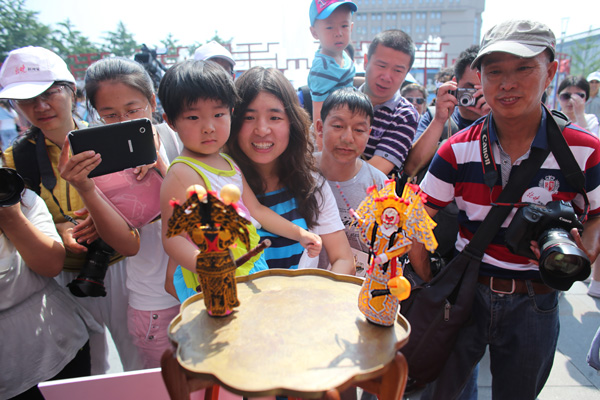 |
|
Spectators in Beijing look at a pair of locally handcrafted toys at the ninth annual China Cultural Heritage Day. The celebrations take place all over the country with Jiangdezhen, Jiangxi province, as the main host city. Wang Jing / China Daily |
As the ancient porcelain kiln blazed in Jingdezhen, high temperatures added to the warmth at this weekend's summertime festival.
China's main celebration for the country's ninth Cultural Heritage Day was in the spotlight in that city in Jiangxi province on Saturday.
The one-day celebration, co-organized by the State Administration of Cultural Heritage and the Jiangxi provincial government, was highlighted by the ignition of the ancient Zhenyao Kiln in the afternoon and also included a traditional porcelain-making and restoration demonstration, a quiz competition on porcelain and numerous special cultural relic exhibitions.
Also, a 50,000-square-meter yuyaochang, which literally means "royal kiln", was designated by the State agency as a national archaeological site park on Saturday morning. This porcelain kiln complex, established in 1369, was used to produce items for emperors in the Ming (1368-1644) and Qing (1644-1911) dynasties.
First built in the early 18th century, Zhenyao Kiln is the only one remaining of about 100 egg-shaped furnaces built in Jingdezhen. The kiln is able to produce 10,000 kilograms of porcelain at one time, consuming 35,000 kg of timber. Jingdezhen is the country's most celebrated hub for porcelain since its founding about 1,700 years ago.
"Thanks to this event, the young generation got a chance to know the almost forgotten old-time kiln using timber as fuel, which is highly demanding for artisans' power of observation and experience," said Hu Jiawang, 70, who has operated kilns for over 50 years. "Temperature and timing are important, as the porcelain can easily be ruined in the fire."
According to historical records, the traditional porcelain-making process in Jingdezhen included 72 steps, and artisans only participated in one step throughout their lives, but Hu said wider usage of modern techniques has endangered some of them.
Hu said revered inheritors of old porcelain techniques now have studios in a park provided by the government to show their skills and simultaneously make ends meet.
There are 52 unearthed ancient porcelain-kiln relics in Jingdezhen. The discovery of the Nanyao Kiln relic of the Tang Dynasty (618-907) was listed among China's top 10 archaeological findings of 2013 by a panel led by the State Administration of Cultural Heritage in April.
"We expect to bring new experiences and feelings (on cultural relics) to the public via today's event," said Li Xiaojie, head of the administration. "This is also a good opportunity for all sides concerned to fulfill their responsibilities to protect relics, promote their capacity to exhibit items and better serve society.
"Cultural relics cannot be stored in attics and remain secret. They should be exposed to people's daily lives. Jingdezhen has set a good example of combining the inheritance of traditions and economic development."
The State Council established the second Saturday in June as China's Cultural Heritage Day in 2006. One city has been annually selected to hold the main celebration since 2009. This year's theme is: "Make cultural heritages alive."
According to Ai Chunlong, head of the city's cultural bureau, more than 100,000 people still take jobs relevant to this traditional craftsmanship.
"No other city in China is more suitable than ours to live up to this year's theme for Cultural Heritage Day," he said.
"Our ancestors in Jingdezhen were good at absorbing skills from all over the country and nurturing their extraordinary characteristics. There was also abundant timber and suitable
climate and earth in Jingdezhen. All factors joined to make this an ideal place to produce the world's top-level porcelain."
More events were held in Xidan Culture Square in downtown Beijing on the same day. A lion dance, a traditional Chinese dance in which two dancers mimic the animal's movements in a lion costume, was performed, along with a Chinese magic show and wuchaozi, a type of martial dance.
The event also features a photo exhibition that tells the stories of 120 of the most significant inheritors of intangible cultural heritage, as well as an interactive exhibition that allows people to see traditional Chinese medicine and the process of creating traditional Chinese arts like calligraphy and medicinal incense-making.
Lin Hongkui, a painter of Peking Opera masks, says there has been an increasing awareness of traditional heritage in recent years. Lin and his team have been asked to teach students in elementary and middle schools about mask painting. They have developed cartoon versions of Peking Opera masks to cater to the young audience.
"There have been more ways to introduce the art of painting masks to people, and wherever we go, people recognize it as a symbol of China."
Contact the writers at wangkaihao@chinadaily.com.cn and sunyuanqing@chinadaily.com.cn
